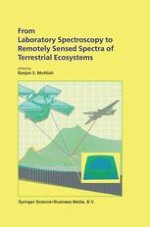2002 | OriginalPaper | Chapter
General Spectral Characteristics of Leaf Reflectance Responses to Plant Stress and Their Manifestation at the Landscape Scale
Authors : Gregory A. Carter, Lee Estep
Published in: From Laboratory Spectroscopy to Remotely Sensed Spectra of Terrestrial Ecosystems
Publisher: Springer Netherlands
Included in: Professional Book Archive
Activate our intelligent search to find suitable subject content or patents.
Select sections of text to find matching patents with Artificial Intelligence. powered by
Select sections of text to find additional relevant content using AI-assisted search. powered by
Remarkably similar results have been reported in a number of studies that evaluated patterns of change in leaf reflectance spectra within the 400–850 nm wavelength range that occur with plant physiological stress. A variety of stressors have been imposed on species ranging from grasses to conifers and deciduous trees. In all cases, the maximum difference between control and stressed states occurred as a reflectance increase near 700 nm. This common response near 700 nm, as well as correspondingly increased reflectance in the green-yellow spectrum, are explained by the tendency of stress to reduce leaf chlorophyll concentration and by the in vivo absorption properties of chlorophyll. To determine the extent to which stress-induced changes in the reflectance of stressed vegetation at the landscape scale may be similar to those observed commonly for individual leaves, a row crop of corn was exposed to various levels of N fertilization, and canopy reflectances were measured using AVIRIS imagery. Changes in corn canopy reflectance with N deficiency were spectrally similar to the commonly observed leaf reflectance responses to stress, with maximum reflectance differences between N-deficient and control plots at 730 nm. Only far-red reflectance increased significantly (P=0.05) with relatively mild N deficiency, but reflectance in the green and far-red spectra correlated equally well with field estimates of leaf chlorophyll and laboratory measurements of leaf N concentration. A complete lack of N fertilizer increased reflectance significantly in both the green and far-red spectra and decreased reflectance in the near-infrared. Additionally, short-term water stress caused changes in corn canopy reflectance that differed from the responses to N deficiency, altering reflectance substantially only in the near-infrared, where it increased by as much as 2.5 percent. Consequently, remote sensing may be used not only to detect plant stress in monoculture stands but also to predict its cause.
